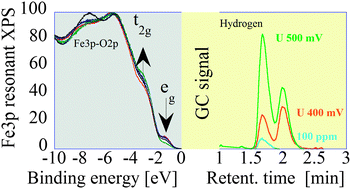Abstract
Solar hydrogen generation by

- This article is part of the themed collection: Electrified surface chemistry
Maintenance work is planned for Wednesday 1st May 2024 from 9:00am to 11:00am (BST).
During this time, the performance of our website may be affected - searches may run slowly and some pages may be temporarily unavailable. If this happens, please try refreshing your web browser or try waiting two to three minutes before trying again.
We apologise for any inconvenience this might cause and thank you for your patience.
* Corresponding authors
a
Laboratory for High Performance Ceramics, Empa. Swiss Federal Laboratories for Materials Science and Technology, CH-8600 Dübendorf, Switzerland
E-mail:
artur.braun@alumni.ethz.ch
Fax: +41 58 765 4150
Tel: +41 58 765 4850
b Research Group of Environmental Chemistry, Department of Inorganic and Analytical Chemistry, University of Szeged, H-6720 Szeged, Hungary
c UFR Sciences et Techniques, Universite de Pau, Cedex, France
d Department of Chemistry, University of Basel, Spitalstrasse, CH-4056 Basel, Switzerland
e Center of Smart Interfaces, Technische Universität Darmstadt, D-64287 Darmstadt, Germany
f Helmholtz Zentrum Berlin, BESSY-II, D-12489 Berlin, Germany
g Laboratory for Photonics & Interfaces, Ecole Polytechnique Federale de Lausanne, CH-1005 Lausanne, Switzerland
Solar hydrogen generation by

 Please wait while we load your content...
Something went wrong. Try again?
Please wait while we load your content...
Something went wrong. Try again?
K. Gajda-Schrantz, S. Tymen, F. Boudoire, R. Toth, D. K. Bora, W. Calvet, M. Grätzel, E. C. Constable and A. Braun, Phys. Chem. Chem. Phys., 2013, 15, 1443 DOI: 10.1039/C2CP42597A
To request permission to reproduce material from this article, please go to the Copyright Clearance Center request page.
If you are an author contributing to an RSC publication, you do not need to request permission provided correct acknowledgement is given.
If you are the author of this article, you do not need to request permission to reproduce figures and diagrams provided correct acknowledgement is given. If you want to reproduce the whole article in a third-party publication (excluding your thesis/dissertation for which permission is not required) please go to the Copyright Clearance Center request page.
Read more about how to correctly acknowledge RSC content.
 Fetching data from CrossRef.
Fetching data from CrossRef.
This may take some time to load.
Loading related content
